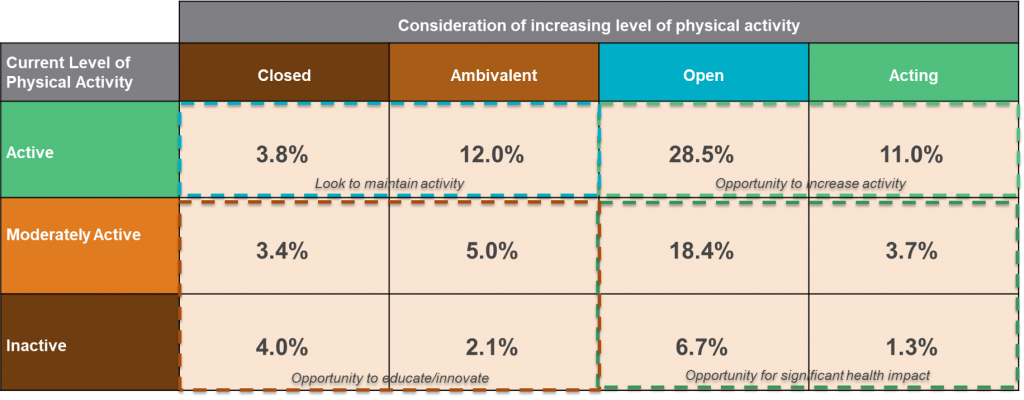“Market segmentation has been described as the cornerstone of modern marketing. It is an analytical process driven by customer needs, which helps maximise resources, emphasizes business strengths and enables more effective and better targeted marketing programs to be developed” Sally Dibb, Professor of Marketing and Society at Coventry University
These same factors are as important for all levels of government who need to use resources at their disposal to deliver services and create positive impacts amongst the population. Segmentation should have an important role to play for planners and decision-makers in local government in designing strategy and initiatives. For example, how do we use segmentation to help tailor strategies and initiatives aimed at addressing physical inactivity.
We are big fans of segmentation at Kinetica. We have developed a segmentation on current and potential physical activity levels. This provides a powerful tool to help local government planners shape their strategies and initiatives designed to increase residents levels of physical activity.
So how do we do it? We use data from our AURA Survey. This interviews a nationally representative sample of 3,000 Australians twice a year. We ask questions about health and wellbeing, physical activity, sport and recreation behaviours and attitudes.
Our AURA data shows there are 44% of Australian adults (9.1m people) that do not meet the physical activity guidelines (defined as doing less than the recommended 150 mins physical activity in a typical week). We also collect information on people’s consideration of increasing their physical activity, which shows that 72% of Australian adults (15m people) are at least open to doing more physical activity, and within this 19% (4m people) are taking action to increase their activity.

Bringing these two measures together creates a simple but powerful market segmentation based on current physical activity behaviour and consideration of doing more.

We utilise our AURA data to create rich segment profiles across demographics, leisure/sport/ recreation behaviours and attitudes, and health and wellbeing metrics. This delivers further insights to inform decision making.
Our proprietary modelling creates this same segmentation at the local level. By that we mean for each of 562 LGA’s across Australia and further localised to the 2307 suburbs. The maps below show the percentage of the population who do not meet the physical activity guidelines but are open to doing more for 3 example LGA’s.

The segmentation and accompanying profiling data enable councils to consider which segments should be targeted or prioritised. It also underpins the design of interventions that are tailored to the needs, motivators and barriers of each of the segments. For example, those who do not currently meet the physical activity guidelines but are open to doing more represent a logical group to target for behaviour change initiatives. Those ambivalent to being more active are better influenced with communications that address any attitudinal barriers like social acceptance.
Kinetica recently conducted a project for Sport and Recreation Victoria which utilised the segmentation and AURA profiling data to assist in developing a strategy for the Get Active Victoria initiative. The analysis and insights delivered a unique understanding of the cohort of the population that are inactive, but wanting to be more active and identified geographic hot spots of this group across the state. These insights will frame the messaging, targeting and placement of Get Active Victoria to maximise impact.
To find out more about AURA and the data for your local area, click here for an intro session http://calendly.com/thekineticagroup/aura-demo-session . And of course, we are here to answer any questions you have, email me at mal@thekineticagroup.com